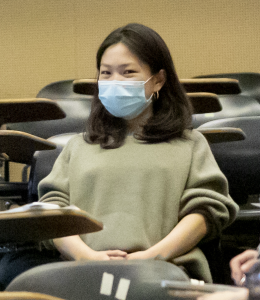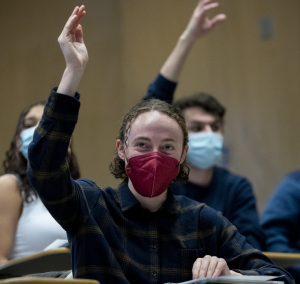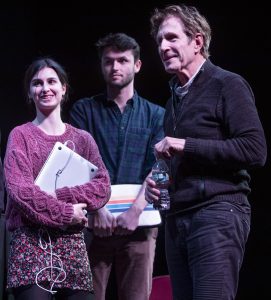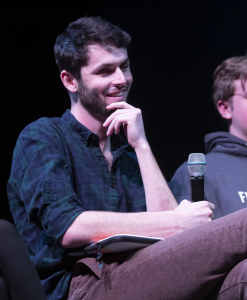By Rabih Chughtai (BFF 2022, Bates Class of 2023)
Many of the most established filmmakers in the world, including George Lucas, Damien Chazelle, Wes Anderson, and Sofia Coppola, got their start in short films. Short films are particularly significant for us at the Bates Film Festival because they tend to be made for the festival circuit, not for wide release or financial success. For this reason, filmmakers of shorts are often excited when we offer to fly them out to our festival where they can see their work screened in a theater to an appreciative audience. This year, filmmaking teams from two of the short films we programmed were able to attend the BFF in Freeport. Programming all of the films for the festival was an amazing experience, but programming shorts, in particular, was incredibly rewarding.
To begin the process of programming shorts, we looked at the 2021 Aspen Shortsfest’s slate. From the descriptions provided on the Aspen website, each of us chose our personal top 10. We provided a synopsis, a projected target community/audience, and any reservations we had about each film we selected. This process made me think critically about what kinds of films we wanted to screen. Rather than simply basing my evaluation on the provided synopses, I was considering how to program for particular audiences, a necessary perspective that ensured solid choices that met our mission-driven goals.

Film critic Kenneth Turan claims that one of the problems with festivals like Sundance is that they have an “unmistakable anti commercial bias” (Turan 46), which can be counterproductive for independent filmmakers. He argues that viewers end up seeing sensitive and artistic films, but these films also have “zero chance of pleasing audiences outside of a festival’s rarefied atmosphere” (Turan 46). This is one of the main factors that differentiates our festival from those like Sundance. Although we appreciate film artistry, we are most interested in starting valuable discussions with our audience, and sometimes, the best way to do that is to screen titles that resonate with general audiences. Our lineup featured film festival staples like Memoria, but we also honored the 40th anniversary of Tron and the 30th anniversary of Mac, knowing that they would be valuable screenings for the community. This methodology also applied to our evaluation of the shorts. We appreciated artistry, but we also sought titles that appealed to a wide audience and that had the potential to generate topical discussions.
“We are most interested in starting valuable discussions with our audience, and sometimes, the best way to do that is to screen titles that resonate with general audiences.”

Following the completion of the Shortsfest Top 10 report, we voted in class and came up with a list of films that the class as a whole was most interested in programming. Some of the films I wanted to see did not make the cut, but I’m glad that we selected films in this way. It gave everyone a voice and an opportunity to go after films that interested them. Each student in the class was assigned 1-2 short films to pursue; this meant reaching out directly to the filmmaker(s) to see if they’d allow us to consider their film for inclusion in our festival. Having this kind of access to filmmakers was one of the early surreal moments for me. As the festival intern in fall 2021, I had reached out to potential celebrity guests, but those efforts tended to lead to either a polite “no” or no response at all. For the shorts, I reached out to Bar Cohen, the director of Her Dance, a short film that examines the treatment of a transgendered family member within a modern Orthodox Israeli family. Cohen was a student at the Steve Tisch School of Film and Television in Tel Aviv, Israel. She got back to me within an hour and graciously granted us access to the film.
“Each student in the class was assigned 1-2 short films to pursue; this meant reaching out directly to the filmmaker(s) to see if they’d allow us to consider their film for inclusion in our festival.”

Watching Her Dance and the many other short films with the class was a really cool experience. We were exposed to content spanning many different genres and addressing a multitude of issues – from immigration and family to COVID and addiction. We had some great conversations about the shorts’ relative success in terms of acting performances, cinematography, and overall message. Being fairly inexperienced with short films, it was eye-opening to think about short-form storytelling and to see how different filmmakers chose to convey their message within a limited time frame. As a writer, it gave me a very unique perspective, and it left me excited about the possibility of writing short films, which will no doubt be informed by these experiences and the conversations we had about these films.
“As a writer, it gave me a very unique perspective, and it left me excited about the possibility of writing short films, which will no doubt be informed by these experiences and the conversations we had about these films.”

The rubric we utilized ensured that we remained faithful to our mission statement. The specific categories on which films were scored included the presentation of diverse perspectives and diverse identities, the mobilization of a visual style that enhanced the film’s thematic message(s), the presence of rich characters and themes, the film’s potential to create meaningful discussions, the film’s relevance to current social, political, and ideological issues, its potential to generate discussions that crossed disciplinary boundaries, and our overall impression. Although this made rating films a bit more complicated than we were used to, it allowed us to evaluate films not only as vehicles of storytelling but also as vehicles for discussion. Keeping the rubric in mind while watching the films was a really peculiar experience. My mind was constantly considering the tie-in to our mission statement. The rubric played a huge role in evaluating films fairly while also understanding their relevance to our particular festival. Sometimes, a film that I was lukewarm on scored higher on my rubric than one that excited me. Looking back, I think the rubric helped us to select the films that best fit the goals of the Bates Film Festival.
“Although [applying our rubric] made rating films a bit more complicated than we were used to, it allowed us to evaluate films not only as vehicles of storytelling but also as vehicles for discussion.”

When it came time to make our festival selections, some of the shorts generated universal enthusiasm among the class. However, once those films were programmed, it became very difficult to decide between the remaining films. We had only a two-hour block, and one of the deciding factors for me became what being in our festival would mean for the films/filmmakers. For example, we considered an acclaimed short that was available on a prominent streaming platform. Ultimately, we decided that while it was a fantastic film, its reach was already extensive, and we felt we could use the same amount of time to spotlight several, shorter, lesser-known films. One film we decided to program was Buy, Sell, Trade, the first film made by Gabriel Cuillier, a former student of Professor Cavallero. Gabe traveled to Maine, saw his film in a theater with an audience, and ended up winning the short film audience award, something that I’m sure meant a lot to a first-time filmmaker.
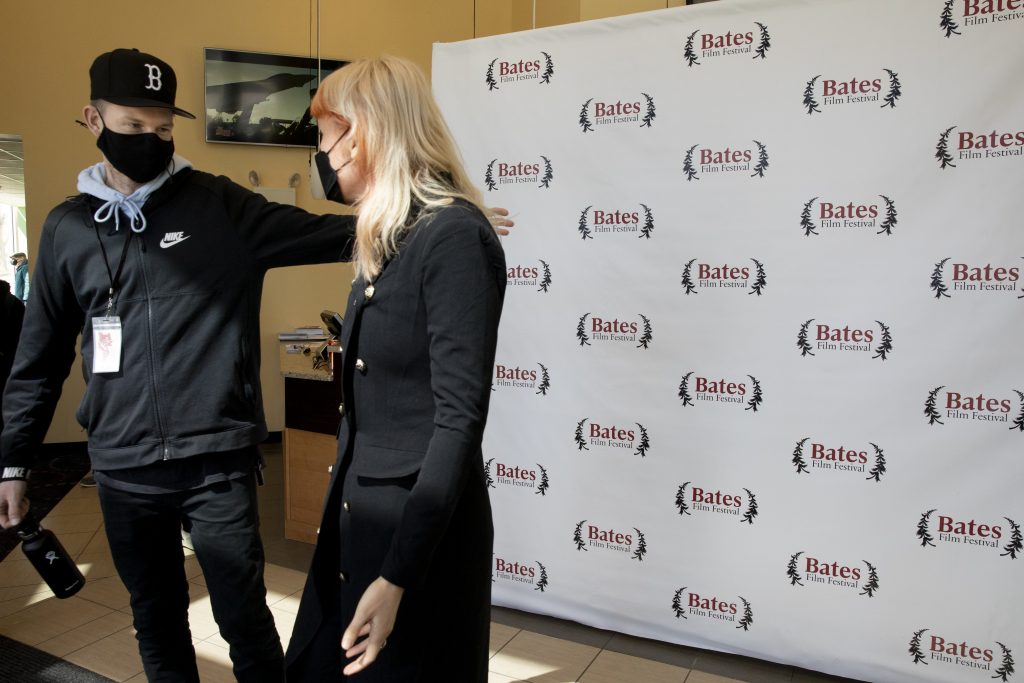
Interestingly, Buy, Sell, Trade and Erin Enberg’s The Getaway, which drew a substantial audience, did not play at the Aspen Shortsfest. The popularity of these films at the BFF tells an intriguing story about what resonated with our audience. In a block that included Oscar-winning filmmakers, these two films became audience favorites. It seems that the BFF audience was less concerned with industry acclaim and awards and more drawn to perspectives with which they could identify or in which they were interested – that of filmmakers who are young, from Maine, and/or come from diverse backgrounds. It suggests that future BFF’s might do well to focus on recruiting more films like these.
“I can’t imagine an environment outside of Bates where we’d have an opportunity like this.”
Ultimately, the control we had as a board of directors was surreal. I can’t imagine an environment outside of Bates where we’d have an opportunity like this. Selecting shorts was particularly important, because it did more than just provide the community with entertainment and access to star filmmakers. It gave passionate, young filmmakers the opportunity to discuss their creative process and cultivate the dialogue they always planned to have with an audience.
Works Cited
Turan, Kenneth. Sundance to Sarajevo: Film Festivals and the World They Made. University of California Press, 2002.



